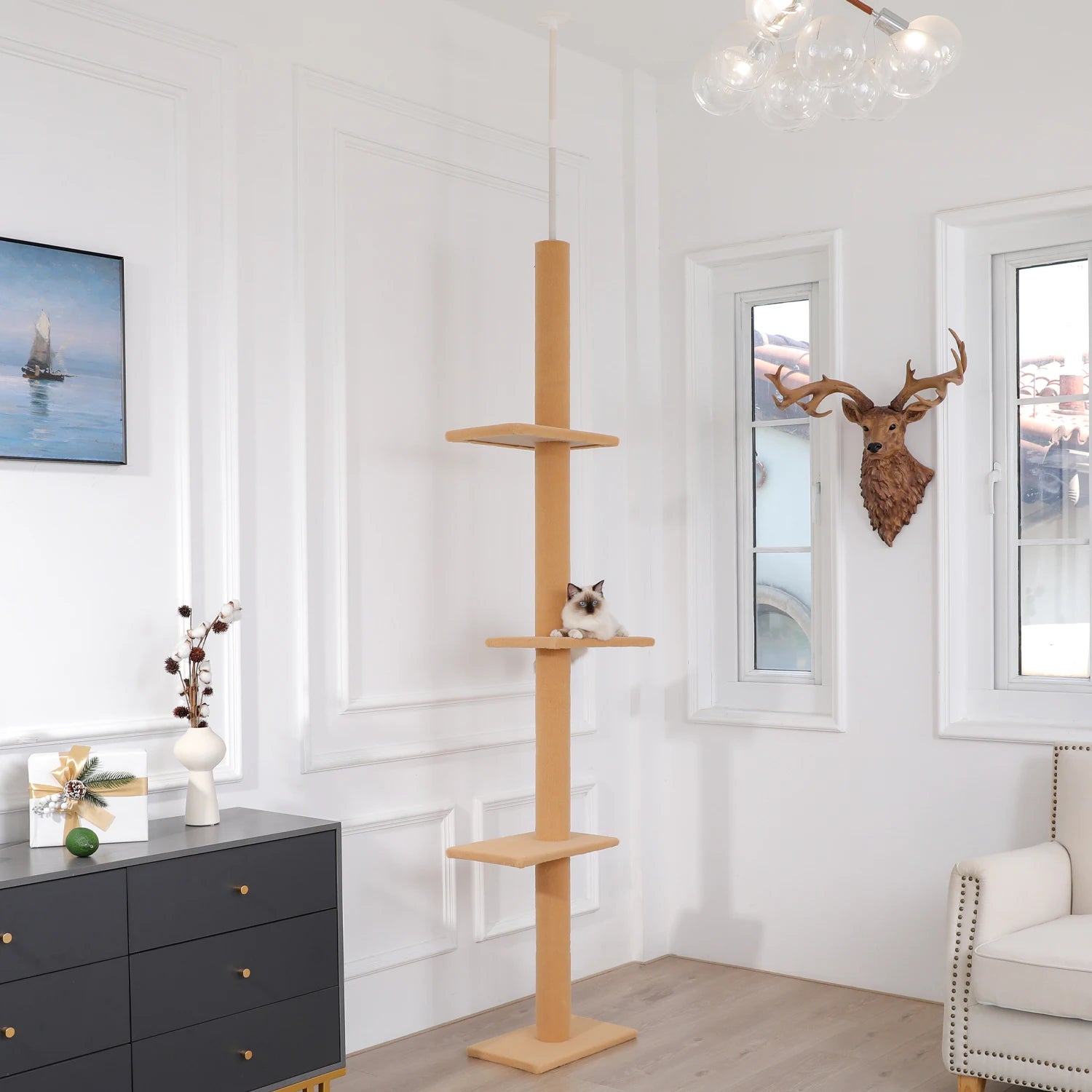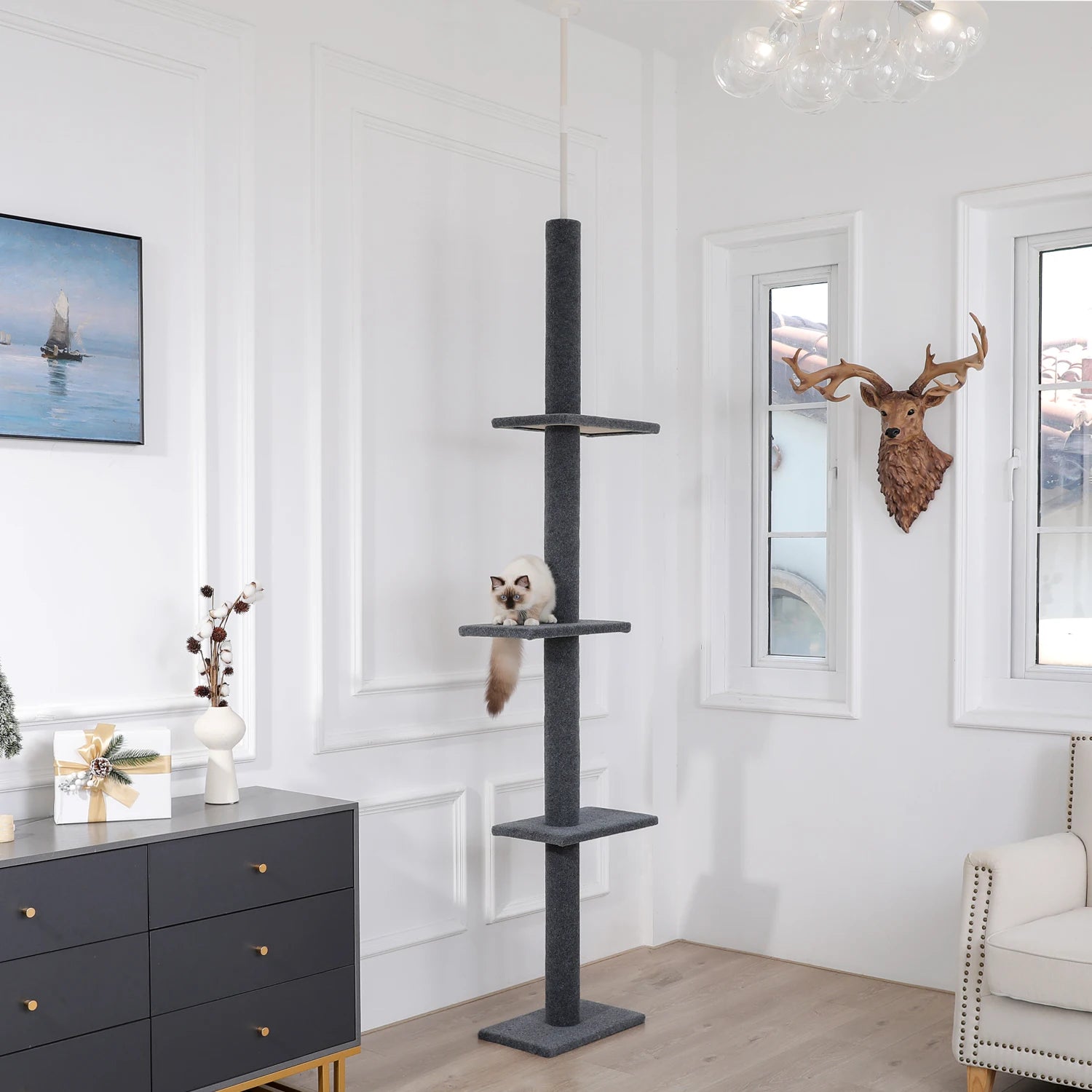Introduction
Indoor cats often lead more sedentary lifestyles compared to their outdoor counterparts, making it crucial to find ways to encourage physical activity. Cat trees play a vital role in promoting healthy exercise for indoor cats. This post explores the numerous benefits of cat trees and how they contribute to the overall well-being of indoor felines.
The Need for Exercise in Indoor Cats
Indoor cats lack the natural stimuli and physical challenges of the outdoors. This can lead to weight gain, lethargy, and behavioral issues. Regular exercise is essential for maintaining a healthy weight, preventing health problems, and stimulating their mind.
The Role of Cat Trees in Physical Activity
- Mimicking Natural Behaviors:
- Cats have an instinctual urge to climb and explore. Cat trees mimic the natural environment, encouraging cats to jump, climb, and balance, which are vital aspects of their physical activity.
- Promoting Healthy Weight:
- Climbing and jumping on a cat tree help cats burn calories, maintain muscle tone, and prevent obesity.
- Enhancing Flexibility and Agility:
- The various levels and platforms of cat tower challenge cats to stretch, reach, and navigate tight spaces, enhancing their flexibility and agility.
- Providing Opportunities for Play:
- Many cat trees come equipped with hanging toys, ropes, and ladders, encouraging play. This type of play is not only fun but also a great form of exercise.
- Reducing Stress and Anxiety:
- Exercise on cat trees can help in reducing stress and anxiety in cats. Physical activity releases endorphins, which have mood-enhancing effects.
The Design Elements of Cat Trees That Encourage Exercise
- Multiple Levels:
- Different heights and platforms encourage climbing, which is a natural and enjoyable form of exercise for cats.
- Sturdy Construction:
- A well-built cat tree allows cats to leap and climb without fear of the structure toppling over, ensuring they can exercise vigorously and safely.
- Integrated Toys and Scratching Posts:
- Toys stimulate hunting instincts, while scratching posts provide an outlet for natural scratching behavior, both of which contribute to physical activity.
- Varied Textures and Materials:
- Different textures and materials entice cats to climb and explore, providing a more stimulating exercise environment.
- Safe and Accessible Design:
- For older or less agile cats, cat trees with easy-to-climb ramps and comfortable resting spots are crucial to encourage gentle exercise.
The Psychological Benefits of Cat Trees
- Territory and Privacy:
- Cat trees offer a sense of ownership and privacy, which is crucial for a cat’s psychological well-being.
- Elevated Viewpoints:
- Cats feel secure when they can survey their environment from a high vantage point, leading to a more relaxed and happy pet.
- A Safe Haven:
- For shy or anxious cats, cat trees provide a safe space to retreat to, helping reduce stress and promoting a sense of security.
Choosing the Right Cat Tree for Your Cat
- Consider Your Cat’s Size and Age:
- Select a cat tree that suits your cat's size and age. Larger cats need sturdier trees with larger platforms.
- Look at the Layout:
- A good layout should have various levels, perches, and possibly ramps or ladders.
- Check the Stability:
- A stable base is essential to prevent tipping when your cat is playing vigorously.
- Assess the Material and Craftsmanship:
- The materials should be durable, safe, and easy to clean.
Maintenance and Safety
- Regular Inspection:
- Regularly inspect the cat tree for wear and tear, loose components, or sharp edges.
- Cleaning:
- Keep the cat tree clean to encourage its use and prevent the spread of germs.
- Placement:
- Place the cat tree in a safe, well-used area of your home to encourage frequent use.
Conclusion
Cat trees are more than just a piece of pet furniture; they are a crucial tool in promoting health and well-being in indoor cats. They provide necessary physical exercise, mental stimulation, and a safe space for cats to express their natural behaviors. When choosing a cat tree, consider your cat’s needs, the tree's features, and its safety and durability. With the right cat tree, your indoor cat can enjoy a healthier, more active, and happier life. Discover Australia's most affordable range of premium cat trees and towers at cattreehaven.com.au where we bring joy to your feline friends with Australia's best cat trees and towers!
FAQs
Q: How often should cats use a cat tree?
A: Ideally, cats should use their cat tree daily for both play and rest. Encourage regular use by integrating the cat tree into playtime and providing treats or toys on the tree.
Q: Can older cats benefit from cat trees?
A: Yes, older cats can benefit from cat trees, especially those designed with easy access and comfortable resting areas. It's a gentle way to encourage them to stay active.
Q: Are cat trees suitable for all cat breeds?
A: Absolutely. However, consider the specific physical and behavioral traits of your breed when choosing a cat tree.
In summary, a cat tree is a vital investment for the health and happiness of indoor cats. It encourages essential physical activities like climbing, jumping, and stretching, while also providing psychological benefits like stress reduction and a sense of security. By choosing the right cat tree and ensuring its safe use, cat owners can greatly enhance their indoor cat's quality of life.



